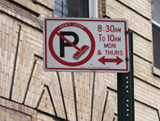  |
Alternate Side Parking
FIND MORE INFO ABOUT BEDBUGS: |
OTHER NEWS
Don't Let the Bedbugs Bite!
Please do not try to exterminate bedbugs yourself. To keep our building safe, It is essential that anyone sighting or suspecting bed bugs promptly report it to Management. Bugs can move quickly to surrounding apartments, so an infestation can grow exponentially. Please speak up as soon as you suspect something! Management will immediately arrange to have the apartment inspected by our specialist. Do not remove furniture from the building if you believe it to be infested with bed bugs. Management will oversee having it wrapped professionally, so as not allow the bugs to spread. Adult bugs have flat, rusty-red-colored oval bodies, about the size of an apple seed. Their victims may get red, itchy welts from the bites. Though they can lurk in picture frames, wall sockets, furniture or in electronics, bed bugs are typically found near their feeding place – your bed. Look for dark bloodstains and bed bug feces around the mattress welting, in the carpet near your bed, and night stand drawers. Prevention includes inspecting your luggage before you return home from travel, and careful inspection of second-hand items. One should not dispose of any potentially infested items without first being advised on how to do so safely by the bed bug specialist, so as not to spread the bugs to someone else’s home. |
|
WATERSENSE™Our water bill is notably higher than similarly sized buildings in NYC. This could be the result of our building having fixtures that predate federal standards set in 1992. If you installed new faucets or showerheads since then, you are likely using 2.5 gallons per minute. Those of us with original fixtures are using more than twice that. Original toilets in our building use 6 gallons per flush. Today, a new toilet uses just 1.6 gallons. If you’re not installing a new toilet soon, there are other options to cut water use. A leaky faucet can waste more than 3,000 gallons a year, so call the Super, fix that gasket or washer. Turn the faucet off while brushing teeth or scrubbing dishes. A $2 aerator on the kitchen faucet, if it’s missing, would help. Even if you have fixtures that meet 1992 standards, you could use 30% less water with innovative showerhead technology. It can give the same flow sensation using just 2 or even 1.5 gpm, with a range of spray types and massaging pulses. The EPA has a Water-Sense label for devices certified to meet their criteria, requiring a sensation better or equal to conventional showerheads, using no more than 2 gpm. If installed in every U.S home, 250 billion gallons could be saved annually. And more billions using WaterSense faucets that reduce water 30% without sacrificing performance. (www.epa.gov/watersense) Home improvement stores and websites offer a multitude of options for 1.5 gallons-per-minute showerheads, ranging in price from $12 to $100. We can easily lower our utility bills, and help the environment. |
||

